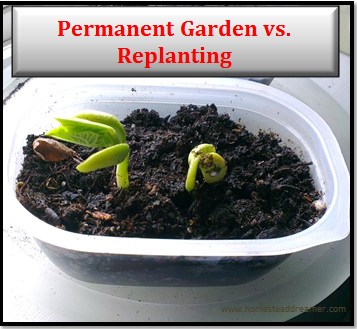One of the things I look forward to most about buying property to homestead on is being able to plant a ‘permanent garden.’ So many of us plant, harvest and then rip everything up out of the ground only to turn around the next year and do it all over again. That is a lot of work! How wonderful would it be to plant herbs and vegetables that just come back year after year?
Modern society would dictate that it is normal to start fresh each year and that crop rotation ‘is a must’ but I beg to differ. I challenge this line of thinking. When you really think about it, everything grew in one general area year after year until someone decided to farm it. Think wild strawberries. Dig up a root and plant it in a pot or raised bed and there you go, you have strawberries. There is no real difference between the two other than location (and the likelihood it will grow larger due to constant care). Now, I am not saying to completely forego the traditional planting practices, far from it. What I am saying is that to not consider and implement certain plants that are more permanent into your overall garden plan is missing out on an opportunity!
Let’s get into why planning a permanent garden is a good idea that has many rewards you may not have considered before. Examples would be: lessening your overall garden workload, taking and cultivating starts to sell or gift (especially from overly large plants), and providing yourself a sustainable and constant source of teas, medicinal herbs, spices, vegetables, and berries.
Lessening the Workload
If you are like me, the garden just isn’t big enough. Then again, we live in an apartment and are lucky to have the greenhouse and cold frames to play with. The point is, it can be really hard to grow all of the things you want to, let alone have the space to grow all the food you need to. If you have the space, planting a permanent garden allows you to have established plants that will produce in the same area year after year. There is less work involved in maintaining them. Just weed, cultivate the soil, and trim dead bits off which is all done only once a year. Then, just feed and water as needed. Instead of starting seeds indoors, transplanting, then planting out and worrying over whether or not the sprout will make the transition, you spend one or two days cleaning up the permanent plants and are done with them until harvest time.
More and more people are turning to growing food in their yards, patio spaces, and windows to help cut down the bills. Food prices aren’t going to go down anytime soon so it is smart to start learning how to grow and preserve your food now. If you ever need to, you will know how and have a much better chance of survival many disasters (always a plus). Herbs and spices in containers are a great and easy way to begin.
Cultivating Starts for Sale
Every year, there are these amazing chive starts for sale at the local nursery. They come from another island where a man has had the same chive mother plants for decades. It grows so large and reseeds itself so well that he is able to actually make money from it. Not to mention he has 100% organic, almost ‘wild’ chives to harvest. They are easily dehydrated for use in soups, stews (including stew starters!), and sautees in the winter. Pretty much free, at that!
Seasonings are expensive, especially for truly organic, fresh ones. Dried spices are also rather spendy, depending on what you are growing. By selling your fresh excess or dehydrating and then selling herbs and spices, you are creating another way of making your garden pay.
Creating a Sustainable Source for Your Needs
In essence, you are planting a mini grocery store for yourself when you plant a permanent garden or at least incorporating a few plants such as fruit trees into your plan. Is there truly anything more satisfying than getting ready to make dinner and walk out to pick everything you will need? An onion here, some broccoli there, maybe a few carrots for color. Your food travels far less than the onion you buy in the store did and you know how it was grown. You controlled the whole process. That is powerful! So, take it a step further. Start with the things your family enjoys and consumes a lot of. It is really that easy!
The internet is a wonderful tool that will teach you virtually anything you need to know for free! There are also lots of inexpensive or free ebooks on Kindle (the app is free, you do not need to own an actual Kindle!) that will take you step by step.
Say you like lavender tea. Grow some! They will reseed themselves each year. How about rhubarb? Rhubarb is one of those plants that can easily get out of hand which makes it a great plant to split out and sell starts or harvest and sell off the excess. There is always the option of giving it to friends and family or even the local soup kitchens who are always grateful for fresh food. You can save hundreds of dollars (and maybe even make money on top of it!) over the year by growing your own food with less work by planting a permanent garden!
Which Plants Are Good for a Permanent Garden?*
- Mint – Prone to taking over wherever it grows. Good for all sorts of applications and likely to produce enough to sell.
- Basil – Grows into large bushes and harvesting only increases output. Fresh for pesto or dehydrated for soups and marinades, it also makes a good gift as part of a spice package.
- Oregano – For the Italian spice lover. Oregano does well in a greenhouse and can overwinter well so long as it does not dry out completely at the roots.
- Lavender – A hardy plant that is great for making anything smell good. Also good for teas, soaps, and lotions.
- Rosemary – An easy to grow, fun herb that is simple to dry and preserve.
- Potatoes – Simply leave a few spuds in the ground and leave them alone. They will come back!
- Onions – Most onions we are used to eating are called ‘walking onions’ due to the way their stalks fall over. The plant hits the ground and roots begin to form, thus ‘walking’
- Rhubarb – Prone to getting out of control. Easily split off to sell as starts or harvest and sell excess.
- Fruit Trees – Though these take a few years before you see any fruit, they are a long term investment that will provide you for decades to come.
- Berry Bushes – Though berry bushes do require trimming to keep under control, having these sweet treats available year after year are truly wonderful. I don’t know many people who wouldn’t jump at the chance to buy fresh berries from you. Likely what will happen though is what isn’t eaten and actually makes it to the processing table will be turned into jams and jellies, dehydrated for trail mixes or frozen for later use.
What are some other things you can plant once and be done with it? Give us a comment below, we love to hear from our readers! Also, scroll down and give us a vote, would ya?







Thanks for the great article. It good when have some knowledge for replanting.
Thank you for the comment Daniel! I am glad you enjoyed the article. I cannot wait to have a permanent garden!
Asparagus is another that will keep coming back. No harvest first year if from seeds, as I understand it.
I hadn’t heard of that one before but it makes a lot of sense. We have sea asparagus here and if left alone for a couple years, can cover an entire beach! Many Alaskan Natives harvest and pickle it for a tasty treat in the winter! Thank you for the comment Melanie!
Jerusalem artichoke , they grow in a hardy environment and will take over if they are not cultivated yearly. They also comoflage themselves with simple flowers .Spearmint is one I have that does well in the cold and heat if planted in a shady spot in my area . I have multiple uses for this one ! Such as in salads, tea, for upset stomach and flatuence .Cools sun burns, bugbite and is great to calm down my headaches. Then there is Garlic ! It will come back if not pulled the first season !